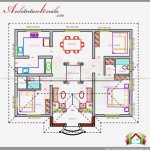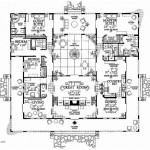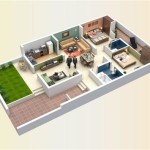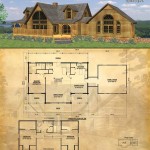Craftsman One-Story Open Floor Plans: A Fusion of Style and Functionality
Craftsman one-story open floor plans represent a popular choice for homeowners seeking a blend of aesthetic appeal and practical living. These designs marry the distinctive architectural characteristics of the Craftsman style with the spaciousness and convenience of an open layout. This article will delve into the key elements of Craftsman architecture, the benefits of open floor plans, and how these two concepts converge to create comfortable and stylish homes.
The Craftsman architectural style, originating in the late 19th and early 20th centuries, is characterized by its emphasis on natural materials, handcrafted details, and a connection to the surrounding environment. This style promotes simplicity, functionality, and a rejection of excessive ornamentation. Key features of Craftsman homes often include low-pitched gable roofs, wide overhanging eaves, exposed rafters, prominent front porches, and the use of natural materials such as wood, stone, and brick.
Open floor plans, on the other hand, prioritize the creation of large, interconnected living spaces. Walls are minimized or entirely eliminated between key areas like the living room, dining room, and kitchen. This design fosters a sense of spaciousness, encourages social interaction, and allows for a greater flow of natural light throughout the home. Open floor plans are particularly appealing to families who value connection and those who enjoy entertaining guests.
The combination of Craftsman aesthetics and open floor plan functionality results in homes that are both visually appealing and highly livable. The integration of these two design principles requires careful planning to ensure that the resulting space maintains the integrity of the Craftsman style while maximizing the benefits of an open layout.
Maintaining Craftsman Character in an Open Floor Plan
Successfully implementing a Craftsman one-story open floor plan requires a deliberate effort to preserve the defining characteristics of the style. While open floor plans inherently minimize walls, strategic design choices can maintain a sense of definition and visual interest without sacrificing the open and airy feel. This involves employing techniques that subtly delineate spaces while adhering to the Craftsman aesthetic.
One effective method is using architectural details to define different zones within the open space. For example, strategically placed columns or partial walls can create visual boundaries between the living room and dining area without completely closing them off. These columns can be crafted from natural wood, often with exposed joinery, to further enhance the Craftsman feel. Similarly, a half-wall topped with built-in bookshelves or display niches can serve as a divider while providing functional storage and visual interest.
Another crucial element is the consistent use of Craftsman-style trim and molding throughout the open space. This includes wide baseboards, substantial door and window casings, and crown molding. These details, typically rendered in natural wood finishes, contribute to the overall sense of craftsmanship and cohesiveness. The type and style of the trim should be consistent throughout the open area to avoid a disjointed appearance.
Ceiling treatments can also play a significant role in defining spaces within an open floor plan. Varying the ceiling height or using different ceiling materials can subtly demarcate different areas. For instance, a coffered ceiling in the living room can visually separate it from the kitchen, which might have a simpler, flat ceiling. Exposed beams, a hallmark of Craftsman architecture, can be strategically placed to define spaces and add a rustic touch. These beams can be stained or left natural, depending on the overall aesthetic of the home.
The strategic use of natural light is paramount. Large windows, often arranged in groupings, are characteristic of Craftsman homes. Maximizing the amount of natural light that enters the open space enhances its spaciousness and connects the interior with the outdoors. Transom windows above doors and windows can also add to the natural light flow and contribute to the architectural detail.
Finally, incorporating built-in elements, such as window seats, fireplace surrounds, and cabinetry, is essential for maintaining the Craftsman character in an open floor plan. These elements not only provide functional storage and seating but also contribute to the overall sense of craftsmanship and attention to detail that defines the style. The use of natural materials and handcrafted details in these built-ins further reinforces the Craftsman aesthetic.
Maximizing Functionality in an Open Craftsman Layout
Beyond aesthetics, the success of a Craftsman one-story open floor plan hinges on its functionality. Careful consideration must be given to space planning, traffic flow, and zoning to ensure that the open layout meets the needs of the occupants. This involves thinking about how the space will be used and how different areas will interact with each other.
Effective zoning is crucial for creating distinct functional areas within the open space. While walls are minimized, it is important to delineate zones for cooking, dining, relaxing, and potentially working. This can be achieved through the use of furniture arrangements, rugs, and changes in flooring materials. For example, a large area rug can define the living room space, while a different flooring material, such as tile or hardwood, can delineate the kitchen area.
Traffic flow is another critical consideration. Pathways should be clear and unobstructed, allowing for easy movement between different areas of the open space. Furniture should be arranged in a way that does not impede traffic flow. In kitchen design, the working triangle (the space between the sink, refrigerator, and stove) should be carefully planned to ensure efficient food preparation.
Storage is often a challenge in open floor plans. To maximize functionality, it is essential to incorporate ample storage solutions throughout the space. This can include built-in cabinetry, shelving, and hidden storage compartments. In the kitchen, maximizing cabinet space and incorporating a pantry are essential for keeping the area organized and clutter-free. In the living room, built-in bookshelves and entertainment centers can provide ample storage for books, media equipment, and other belongings.
Noise control is also an important consideration in open floor plans. Without walls to absorb sound, noise can travel easily throughout the space. To mitigate this, consider using sound-absorbing materials, such as rugs, curtains, and upholstered furniture. Adding a ceiling fan can also help to circulate air and mask noise. For areas where privacy is desired, such as a home office, consider incorporating a partial wall or using soundproof doors.
Finally, consider the connection between the interior and exterior spaces. Craftsman homes often feature large porches and outdoor living areas. Integrating the indoor and outdoor spaces through the use of large windows, sliding doors, and outdoor patios can extend the living area and create a seamless transition between the inside and outside.
Material Selection and Craftsmanship in Craftsman Open Designs
The choice of materials is paramount in achieving an authentic Craftsman aesthetic within an open floor plan. The emphasis should be on natural, durable materials that evoke a sense of warmth, craftsmanship, and connection to nature. The selection and application of these materials should reflect the principles of honesty and simplicity that define the Craftsman style.
Wood is the quintessential material in Craftsman architecture. Whether used for flooring, trim, cabinetry, or structural elements, wood adds warmth, texture, and visual interest to the space. Common wood species used in Craftsman homes include oak, maple, cherry, and fir. These woods can be stained or left natural, depending on the desired aesthetic. The use of exposed wood beams, particularly in the ceiling, is a classic Craftsman detail that can add a sense of rustic charm to the open space.
Stone and brick are also frequently used in Craftsman homes, often for fireplaces, exterior accents, and foundation walls. These materials add a sense of permanence and solidity to the design. The use of natural stone, such as river rock or fieldstone, can further enhance the connection to the surrounding environment. Brick can be used in a variety of patterns and colors to create visual interest. Both stone and brick should be incorporated thoughtfully and strategically to complement the other materials in the space.
The use of handcrafted details is essential for capturing the spirit of the Craftsman style. This can include custom-built cabinetry, hand-carved moldings, and unique lighting fixtures. The emphasis should be on quality craftsmanship and attention to detail. Consider incorporating handcrafted tiles in the kitchen or bathroom to add a touch of artistry to the space. Look for artisans who specialize in traditional Craftsman techniques to create truly authentic details.
Lighting plays a crucial role in defining the ambiance of a Craftsman open floor plan. Choose lighting fixtures that are consistent with the style, such as pendant lights with mica shades or sconces with art glass details. The lighting should be warm and inviting, creating a cozy and comfortable atmosphere. Consider using dimmer switches to adjust the lighting levels for different times of day and activities.
Finally, pay attention to the details. Hardware, such as door knobs, hinges, and drawer pulls, should be carefully selected to complement the overall aesthetic. Choose hardware made from natural materials, such as bronze or iron, with a handcrafted look. These small details can make a big difference in the overall look and feel of the space.

4 Bedroom 1 Story Modern Farmhouse Style Plan With Outdoor Living Area And Bonus Room Westchester Craftsman House Plans

One Or Two Story Craftsman House Plan Country Plans

Floor Plans Aflfpw76173 1 Story Craftsman Home With 3 Bedrooms 2 Bathrooms And 520 Total Ranch Open Concept House One

Craftsman Ranch House Plan With Open Concept Living Space 420003wnt Architectural Designs Plans

One Story Traditional Home Plan With 3 Beds And Baths In 1800 Sq Ft Of Living Space Craftsman House Plans Style Ranch

Beautiful 4 Bedroom Craftsman Style Single Story Home Floor Plan And Photos

Exclusive One Story Craftsman House Plan With Two Master Suites 790001glv Architectural Designs Plans

Craftsman Style House Plan 3 Beds 2 Baths 1550 Sq Ft 427 5 Ranch Plans New

Must Have One Story Open Floor Plans Blog Eplans Com

Craftsman Style House Plans Big And Small Houseplans Blog Com








